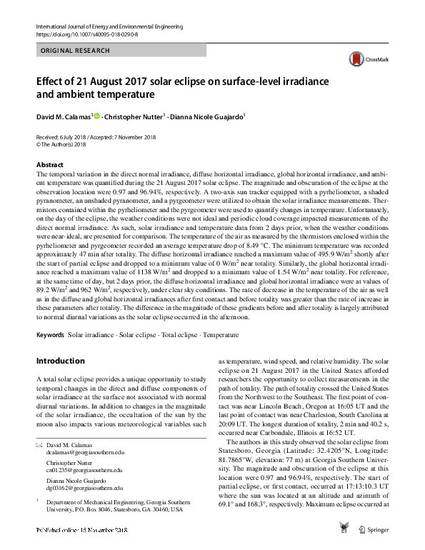
Article
Effect of 21 August 2017 Solar Eclipse on Surface-Level Irradiance and Ambient Temperature
International Journal of Energy and Environmental Engineering
(2018)
Abstract
The temporal variation in the direct normal irradiance, diffuse horizontal irradiance, global horizontal irradiance, and ambient temperature was quantified during the 21 August 2017 solar eclipse. The magnitude and obscuration of the eclipse at the observation location were 0.97 and 96.94%, respectively. A two-axis sun tracker equipped with a pyrheliometer, a shaded pyranometer, an unshaded pyranometer, and a pyrgeometer were utilized to obtain the solar irradiance measurements. Thermistors contained within the pyrheliometer and the pyrgeometer were used to quantify changes in temperature. Unfortunately, on the day of the eclipse, the weather conditions were not ideal and periodic cloud coverage impacted measurements of the direct normal irradiance. As such, solar irradiance and temperature data from 2 days prior, when the weather conditions were near-ideal, are presented for comparison. The temperature of the air as measured by the thermistors enclosed within the pyrheliometer and pyrgeometer recorded an average temperature drop of 8.49 °C. The minimum temperature was recorded approximately 47 min after totality. The diffuse horizontal irradiance reached a maximum value of 495.9 W/m2 shortly after the start of partial eclipse and dropped to a minimum value of 0 W/m2 near totality. Similarly, the global horizontal irradiance reached a maximum value of 1138 W/m2 and dropped to a minimum value of 1.54 W/m2 near totality. For reference, at the same time of day, but 2 days prior, the diffuse horizontal irradiance and global horizontal irradiance were at values of 89.2 W/m2 and 962 W/m2, respectively, under clear sky conditions. The rate of decrease in the temperature of the air as well as in the diffuse and global horizontal irradiances after first contact and before totality was greater than the rate of increase in these parameters after totality. The difference in the magnitude of these gradients before and after totality is largely attributed to normal diurnal variations as the solar eclipse occurred in the afternoon.
Keywords
- Solar irradiance,
- Solar eclipse,
- Total eclipse,
- Temperature
Disciplines
Publication Date
November 15, 2018
DOI
10.1007/s40095-018-0290-8
Publisher Statement
© The Author(s) 2018. This article is distributed under the terms of the Creative Commons Attribution 4.0 International License (http://creativecommons.org/licenses/by/4.0/), which permits unrestricted use, distribution, and reproduction in any medium, provided you give appropriate credit to the original author(s) and the source, provide a link to the Creative Commons license, and indicate if changes were made. Article retrieved from International Journal of Energy and Environmental Engineering.
Citation Information
David Calamas, Christopher W. Nutter and Dianna N. Guajardo. "Effect of 21 August 2017 Solar Eclipse on Surface-Level Irradiance and Ambient Temperature" International Journal of Energy and Environmental Engineering (2018) p. 1 - 10 ISSN: 2251-6832 Available at: http://works.bepress.com/david_calamas/28/
